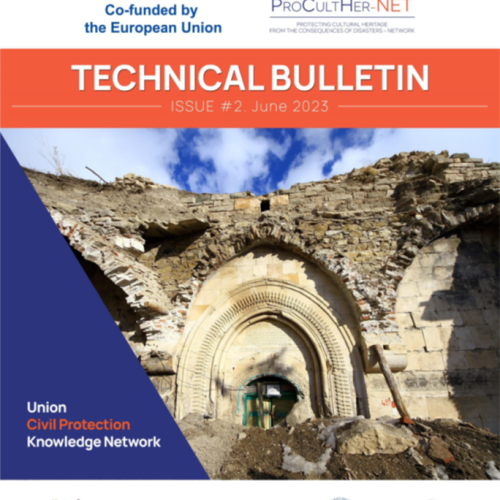A foreword by Catherine Magnant, Head of Cultural Policy Unit and Deputy to the Director, Directorate-General for Education, Culture, Youth and Sport- DG EAC - European Commission, introduces this second edition. This issue opens on a case study by the Türkiye Ministry of Culture and Tourism. The wide-ranging intervention at the Sümela Monastery, going from restoration of the buildings and infrastructures to a rock stabilisation operation, is a powerful example that illustrates the PREVENTION section.
For its PREPAREDNESS section, this Technical Bulletin presents best practices collected in the field of training, a theme that has been at the centre of PROCULTHER-NET activities in the past months.
Training is the alpha and the omega of preparedness. Workshops are a powerful capacity-building tool for raising awareness, developing skills and creating momentum. The nation-wide workshops led by the Research and restoration centre of the museums of France - C2RMF is a striking example of the way training can give impulse to make preparedness policies a reality and not just a possibility, providing museum professionals a step-by-step guidance to draft a Safeguarding Plan.
But training is also essential as the last step of preparedness. An emergency plan is not operational until it has been put into practice, vetted and upgraded, in a continuous improvement cycle. Conducting exercises is therefore necessary to test emergency plans, to practice technical gestures such as handling and packing of movable heritage, to be ready to respond to unforeseen contingencies and, last but not least, to learn to work together as a multi-disciplinary team. Such experience was provided to the experts who took part in the two training sessions organised by PROCULTHER-NET in Volterra (Italy) in March 2023, described in an article by the Italian Civil Protection Department- DPC.
In this edition, the RESPONSE section is focusing on the theme of data and apps. The ongoing war in Ukraine has stressed the importance of such digital tools, with the development and field-testing of several downloadable apps to quickly digitise or to assess cultural heritage in emergencies. Three PROCULTHER-NET partners, the International Centre for the Study of Preservation and Restoration of Cultural Property – ICCROM, the German Archaeological Institute - DAI and the DPC share here their complimentary experiences and on-going work in this rapidly developing sector.
To complete the picture on the use of new technologies, the Italian National Fire and Rescue Service - CNVVF reports on the experimental use of the LiDAR in post-seismic assessment of immovable cultural heritage.
A contribution of the Unit for Risk Management and Emergencies in Cultural Heritage of Castilla y Leon - UGRECYL concludes the Response section, by analysing the impact of forest fires on rural cultural heritage – a pressing subject as the summer season is approaching.
Under RECOVERY, the Italian Ministry of Culture - MiC makes the case for sorting rubbles of immovable cultural heritage, based on the experience of the 2016 earthquake and its devastating impact on the Basilica of Norcia. This patient and meticulous approach is a cornerstone to ensure reconstruction and to preserve the historical and cultural fabric of a site affected by a disaster.
To conclude this 2nd Technical Bulletin – and to return to and wrap up the theme of data – the FOCUS ON section looks into the recording of damage to cultural heritage. What do we lose when lose cultural heritage? How do we measure it? In its article, the University of Porto - UPORTO advocates for and proposes a standardized methodology to record damage to immovable cultural heritage, an essential yet missing tool in better understanding vulnerabilities and reducing hazard exposure.
Issue #1 - March 2023 - is still avaiable, find the links below to download both issues, enjoy reading and spread them!
Experts working in the field of protection of #CulturalHeritage at risk wishing to contribute to the next issues in 2024 or simply share suggestions to improve it are called to fill in the survey launched.
Click here to access the survey (closed November 2023)
